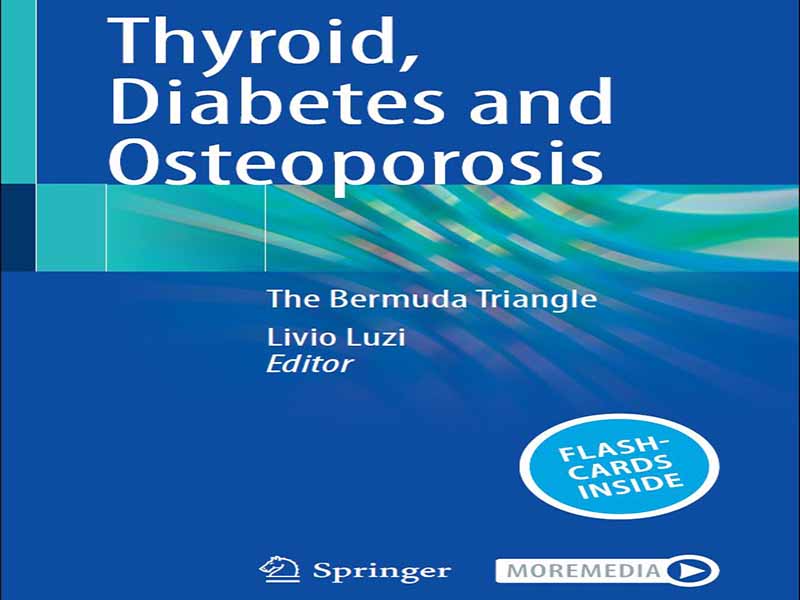- عنوان کتاب: Thyroid, Diabetes and Osteoporosis
- نویسنده: Livio Luzi
- حوزه: تیروئید، دیابت، پوکی استخوان
- سال انتشار: 2025
- تعداد صفحه: 379
- زبان اصلی: انگلیسی
- نوع فایل: pdf
- حجم فایل: 7.39 مگابایت
با در نظر گرفتن شرایط بالینی آشکار و مراحل پیشبالینی کمکاری تیروئید، دیابت نوع ۲ و پوکی استخوان، بین ۵۰ تا ۷۰ درصد از جمعیت عمومی ممکن است یک بیماری واحد یا ترکیبی از دو یا سه بیماری داشته باشند.
در ایتالیا، ۱۰ میلیون نفر (از ۶۰ میلیون نفر) مبتلا به پیشدیابت یا دیابت هستند؛ تقریباً ۵۰ درصد از جمعیت (۳۰ میلیون نفر) دچار استئوپنی یا پوکی استخوان هستند (زنان بیشتر از مردان به این بیماری مبتلا هستند) و تا ۱۰ درصد از جمعیت (عمدتاً زنان) مبتلا به کمکاری تیروئید (بالینی و تحت بالینی) هستند. در سراسر جهان، بیش از ۵۳۷ میلیون بزرگسال (۲۰ تا ۷۹ سال) در سال ۲۰۲۱ با دیابت زندگی میکردند (انتظار میرود تا سال ۲۰۴۵ به ۷۸۳ میلیون نفر برسد). تخمین زده میشود که تقریباً ۵۰۰ میلیون نفر در سراسر جهان مبتلا به پوکی استخوان هستند، که از هر ۳ زن، ۱ نفر و از هر ۵ مرد بالای ۵۰ سال، ۱ نفر شکستگیهای ناشی از پوکی استخوان را تجربه میکند. شیوع جهانی کمکاری تیروئید متفاوت است، اما تخمینها نشان میدهد که حدود ۵٪ از جمعیت مبتلا به کمکاری تیروئید بالینی هستند و موارد تحت بالینی، شیوع کلی را در بسیاری از مناطق به ۱۰٪ یا بیشتر میرساند.
اگرچه با پاتوژنز متفاوت، هر سه بیماری باعث افزایش عوارض و مرگ و میر میشوند. هر سه بیماری در مراحل مختلف سیر طبیعی بیماری ممکن است باعث پیری زودرس و ناتوانی شوند و باعث اختلال چشمگیر در کیفیت زندگی شوند.
در میان تمام بیماریهای غیرواگیر، اختلال عملکرد تیروئید، دیابت شیرین و پوکی استخوان با عوارض آنها (حوادث قلبی عروقی، اختلال شناختی و شکستگی) احتمالاً مرتبطترین بیماریهای مزمن برای تعیین افزایش هزینههای سازمانهای بهداشتی در سراسر جهان هستند.
اینکه آیا این سه بیماری بالینی یک مسیر بیماریزای مشترک دارند یا خیر، بعید است. با این وجود، عوامل همپوشانی زیادی وجود دارد که منجر به عوارض بالقوه یکسان میشوند. اولاً، دیابت شیرین و عملکرد کمکاری یا پرکاری تیروئید از علل شایع بیماریهای قلبی عروقی هستند. ثانیاً، عملکرد پرکاری تیروئید شکنندگی استخوان را افزایش میدهد. ثالثاً، خود پوکی استخوان امروزه در میان عوارض دیابت نوع ۱ و نوع ۲ ذکر شده است. در نهایت، کمکاری تیروئید ممکن است شیوع چاقی را افزایش دهد و برعکس باعث افزایش دیابت نوع ۲ در جمعیت عمومی شود. همه این جنبهها در کتاب حاضر مورد تجزیه و تحلیل عمیق قرار خواهند گرفت.
از همه این ملاحظات، عنوان فرعی این کتاب استخراج میشود: مثلث برمودا. مانند مثلث جغرافیایی که از برمودا، پورتوریکو و فلوریدا تشکیل شده است، این سه بیماری بالینی ممکن است در تعیین عوارض تهدیدکننده زندگی با هم تعامل داشته باشند و مرگ و میر کلی را افزایش دهند. مانند افسانه مثلث برمودا، ممکن است تصاویر بالینی همپوشانی، گیجکننده و متضادی وجود داشته باشد که احتمالاً مربوط به مراحل پیشبالینی سه بیماری (کمکاری تیروئید، پیشدیابت، استئوپنی) است که ممکن است به اندازه بیماریهای آشکار مرتبط خطرناک و کشنده باشند، اگرچه اغلب بدون علامت و نامرئی هستند.
تجزیه و تحلیل کامل شواهد پزشکی موجود که در اینجا ارائه شده است، به آشکار کردن تأثیر واقعی اختلال عملکرد تیروئید، دیابت و تغییر متابولیسم استخوان بر میزان ابتلا و مرگ و میر کمک خواهد کرد، مشابه آنچه در سالهای اخیر برای رد افسانه مثلث برمودا انجام شده است. هیچ موجود بیگانهای در برمودا باعث فجایع دریایی و هوایی نشده، بلکه شرایط نامساعد فیزیکی و آب و هوایی باعث آن شده است. به همین ترتیب، توجه دقیق به سبک زندگی پرهیزگارانه، به کارگیری اصول پزشکی دقیق و رویکردی مبتنی بر جنسیت، در درک، پیشگیری و درمان بهتر اختلال عملکرد تیروئید، دیابت و پوکی استخوان موفق خواهد بود.
در نهایت، میخواهم این کتاب را به دو روح – که هرگز دوست هم نبودهاند – علم غدد درونریز، یعنی متخصص دیابت و متخصص غدد درونریز، تقدیم کنم. در گذشته، من حرفه پزشکی خود را به عنوان یک “متخصص دیابت خالص” با توجه به اینکه سایر بیماریهای غدد درونریز ثانویه – اگر نه خستهکننده – بودند، آغاز کردم. در “فرآیند پیری فیزیولوژیکی دانشگاهی” خود، متوجه شدم که ارتباط نزدیک بین دیابت و اکثر بیماریهای غدد درونریز، درمان دیابت را بدون دانش عمیق از تمام طیف بیماریهای غدد درونریز غیرممکن میکند. بنابراین، اثر حاضر ثمره دوران تحصیلی من است و عمدتاً به متخصصان جوانی که در این منطقه کار میکنند اختصاص داده شده است و آنها را ترغیب میکند که از بیماریهای متابولیک تا غدد درونریز را بدون تقسیمبندی دقیق بررسی کنند، اما در مقابل، آنها را به عنوان یک واحد در نظر بگیرند. این رفتار حرفهای به آنها (و بیمارانشان) کمک میکند تا بدون هیچ آسیبی از مثلث برمودا عبور کنند!
Considering together the overt clinical conditions and the preclinical stages of hypothyroidism, type 2 diabetes mellitus, and osteoporosis, between 50% and 70% of the general population, may have one single disease, or the overlapping of two and three diseases.
In Italy, 10 million people (out of 60 million) have prediabetes or diabetes; approximately 50% of the population (30 million people) have osteopenia or osteoporosis (more women than men are affected), and up to 10% of the population (mainly females) is affected by hypothyroidism (clinical and subclinical). Worldwide, over 537 million adults (20–79 years) were living with diabetes in 2021 (expected to rise to 783 million by 2045). Approximately 500 million people worldwide are estimated to have osteoporosis, with 1 in 3 women and 1 in 5 men over 50 experiencing osteoporotic fractures. The global prevalence of hypothyroidism varies, but estimates suggest around 5% of the population has clinical hypothyroidism, with subclinical cases pushing overall prevalence to 10% or more in many regions.
Although with different pathogenesis, all three conditions induce an increase in morbidity and mortality. All three conditions in different stages of the natural history of the disease may induce accelerated aging and invalidity, causing a dramatic impairment of quality of life.
Among all noncommunicable diseases, thyroid dysfunction, diabetes mellitus, and osteoporosis with their complications (cardiovascular events, cognitive impairment, and fractures) are likely to be the most relevant chronic diseases to determine the increase of Health Organizations costs worldwide.
Whether the three clinical conditions share a common pathogenic pathway is unlikely. Nonetheless, there are many overlapping factors leading to the same potential complications. Firstly, diabetes mellitus and hypo- or hyperthyroid function are common causes of cardiovascular disease. Secondly, hyperthyroid function increases bone fragility. Thirdly, osteoporosis itself is listed today among the complications of type 1 and type 2 diabetes. Lastly, hypothyroidism may increase obesity prevalence and conversely induce type 2 diabetes increment in the general population. All those aspects will undergo an in-depth analysis in the present book.
From all these considerations derives the subtitle of this book: The Bermuda Triangle. Like the geographic triangle constituted by Bermuda, Puerto Rico, and Florida, the three clinical conditions may interact in determining life-threatening complications, increasing the overall mortality. Like in the Bermuda Triangle myth, overlapping, confusing, and contrasting clinical pictures may be present, probably related to the preclinical stages of the three diseases (hypothyroid function, prediabetes, osteopenia) which may be as dangerous and as lethal as the related overt diseases, although often asymptomatic and invisible.
A thorough analysis of existing medical evidence as presented herein will help
to unravel the real impact of thyroid dysfunction, diabetes, and altered bone metabolism on morbidity and mortality, similarly to what was done in recent years to disprove the Bermuda Triangle myth. No alien entities in the Bermuda were causing the naval and aircraft disasters, but adverse physical and weather conditions. Similarly, strict attention to virtuous life style, the application of precision medicine principles, and a gender-related approach will succeed in understanding, preventing, and treating better thyroid dysfunction, diabetes, and osteoporosis.
Finally, I wish to dedicate this book to the two souls—never friends—of the Endocrinology science, namely, the Diabetologist and the Endocrinologist. In the old days, I began my medical career as a “pure diabetologist” considering the other endocrine diseases secondary—if not boring. In my “physiological academic aging process,” I realized that the close interrelationship between diabetes and most other endocrine diseases makes it impossible to treat diabetes without a profound knowledge of all endocrine disease spectrum. Thus, the present work is a mature fruit of my academic career and is mainly dedicated to young professionals working in the area, urging them to span from metabolic to endocrine diseases without close compartmentalization but, in contrast, considering them as a unity. This professional behavior will help them (and their patients) to pass through the Bermuda Triangle unharmed!
این کتاب را میتوانید از لینک زیر بصورت رایگان دانلود کنید:
Download: Thyroid, Diabetes and Osteoporosis




































نظرات کاربران